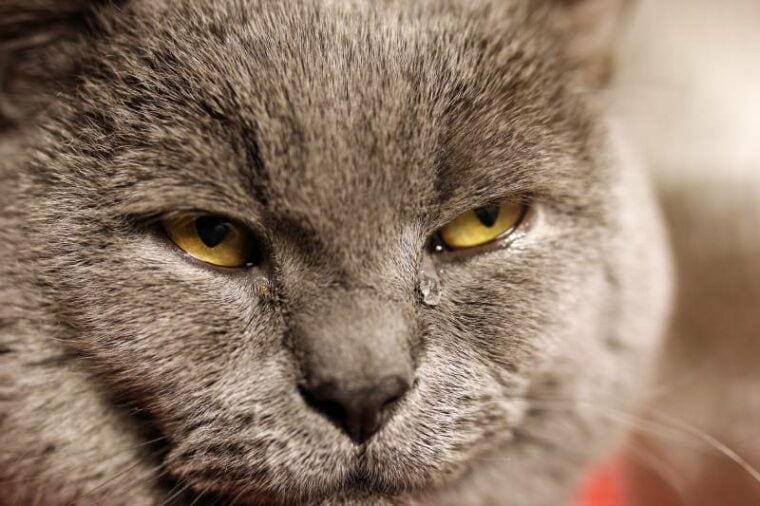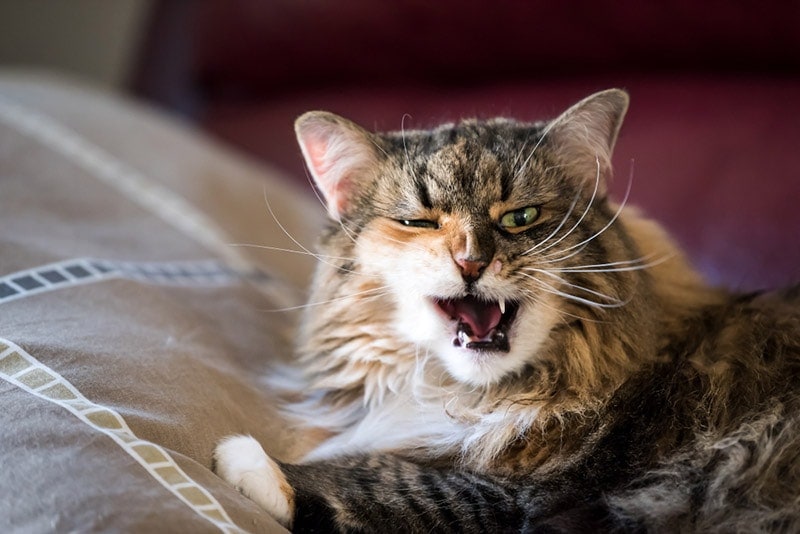
Cats have a reputation for being mysterious and aloof creatures. As pet owners, we often wonder if cats experience emotions and if they cry like humans do. Tears are commonly associated with sadness or pain in humans, but what about our feline companions? While cats do have tears and can cry in the sense that they vocalize as a means of communication, they do not cry tears due to emotional reasons like humans.
Cats’ tears serve a function very similar to that of tears in humans, but they are different from the way humans express their emotions through crying. In this article, we will explore how cats cry, the function of their tears, and what it means when our beloved cats display signs of tearfulness.
Do Cats Cry with Tears?
When we think of crying, we usually imagine tears streaming down our faces. However, cats do not shed tears in the same way that humans do. According to a 2019 study, humans are the only animals on Earth that cry when we are sad.1
Unlike us, cats do not possess the same emotional response that triggers the production of tears. While they may not cry in the conventional sense, cats have their own ways of expressing their emotions and discomfort.

How Do Cats Cry?
Cats express their emotions through a range of vocalizations, body language, and behaviors. They communicate their needs and feelings using meows, purring, hissing, growling, and other distinct sounds.
Additionally, cats may display physical cues such as flattened ears, dilated pupils, raised fur, or a swishing tail to convey their emotional state.
Cat’s Tears Explained
While cats may not cry tears of sadness or joy like humans do, they do produce tears naturally for several purposes.
Tear production in cats serves a vital role in maintaining the health and well-being of their eyes. Tears help lubricate the eyes, keeping them moist and protected from irritants such as dust, debris, or foreign objects. Tears also play a role in vision, nutrition and protection against infections. The composition of cat tears is slightly different from human tears, reflecting their unique needs.

Why Do Cats Cry?
Although cats do not cry tears of emotion, they can exhibit signs of ocular discomfort that may resemble crying. There are several reasons why cats may display tearfulness. One common cause is conjunctivitis, which can be triggered by infections, allergies, or immune-mediated problems. Other common causes include wounds (ulcers), foreign bodies (something inside the eye) or irritation. Excessive tearing in these cases is the way the eye responds to relieve discomfort, flushing out irritants from the eyes or healing a wound.
Another possible reason for tearfulness in cats is blocked tear ducts. Some cats may have obstructed tear ducts, meaning tears can’t drain out properly and leading to tears overflowing onto their fur. Veterinary attention is necessary to address all the conditions listed above.
How Do They Communicate Their Emotions?
Cats communicate their emotions through various non-verbal cues, and understanding these expressions can enhance your understanding of your feline companion.
One such communication method is purring. While purring is commonly associated with contentment, it’s important to note that cats may also purr when they are in pain or distress. To decipher the meaning behind the purring, it’s crucial to consider other signs and the context in which it occurs.
The position of a cat’s tail also provides valuable insights into their emotional state. A straight and upright tail generally signifies confidence, while a tucked tail indicates fear or submission. By paying attention to your cat’s tail movements, you can gauge their mood and respond accordingly.
Another significant indicator of a cat’s emotional state is the position of their ears. When a cat’s ears are forward-facing, it signifies alertness and curiosity. On the other hand, flattened ears suggest fear or aggression.
By understanding these body language behaviors, you can accurately interpret your cat’s needs and emotions.

What Do Cats Do When They’re Anxious?
Cats are creatures of habit and might experience stress when faced with change in their immediate environment. Cats experiencing stress and anxiety may seek solace in quiet spaces, show aggression, have a reduced appetite, and appear lethargic with a lack of energy and enthusiasm for playtime or interaction.
Not all cats exhibit these behaviors the same way, but monitoring any unusual behavior and seeking veterinary attention if necessary is important as cat parents.
What Do Cats Do When They’re in Pain?
When cats are in pain, they may exhibit various signs that indicate their discomfort. Although they cannot express their pain in words, cats communicate through their behavior, body language, and facial expressions. You may notice changes in their vocalization habits or in the way they move and interact, while others may keep to themselves and remain quiet.
A common indicator of pain to look out for is changes in their posture and movement. Cats in pain may adopt unusual postures or movements to alleviate discomfort. They may hunch their bodies, favor certain limbs, or move more slowly and cautiously. Cats in pain may become sensitive to touch and avoid being petted or handled. They may flinch, hiss, or even try to bite when touched in a painful area.
Another sign that your cat is in pain is loss of appetite. Pain can significantly impact a cat’s appetite and drinking habits. They may show a decrease in food intake or water consumption due to the discomfort they are experiencing.

What Should I Do If I See My Cat Has Tears?
If you notice that your cat has tears, it is essential to investigate the underlying cause as soon as possible. Excessive tearing can be a symptom of various issues, including ulcers, eye infections, allergies, or a blockage in the tear ducts.
Pay attention to your cat’s overall behavior, including any other signs of discomfort or distress. Take note of how long the tearing persists and whether there are any visible changes in the eye. Also take this time to examine your cat’s surroundings for potential irritants that may be causing eye irritation. Contact your vet immediately so that they can perform a thorough examination, determine the underlying cause, and recommend appropriate treatment options.
Conclusion
While cats do not cry tears as humans do, they possess their own unique ways of expressing emotions, discomfort, and pain. In the same way as in humans, cats’ tears play a crucial role in maintaining the health of a cat’s eyes, but their production is primarily for lubrication and protection rather than emotional expression.
But just because they don’t cry like humans doesn’t mean they’re not experiencing discomfort. As cat parents, it’s important to monitor your cat’s overall behavior by looking out for unusual changes.
Featured Image Credit: chrupka, Shutterstock








